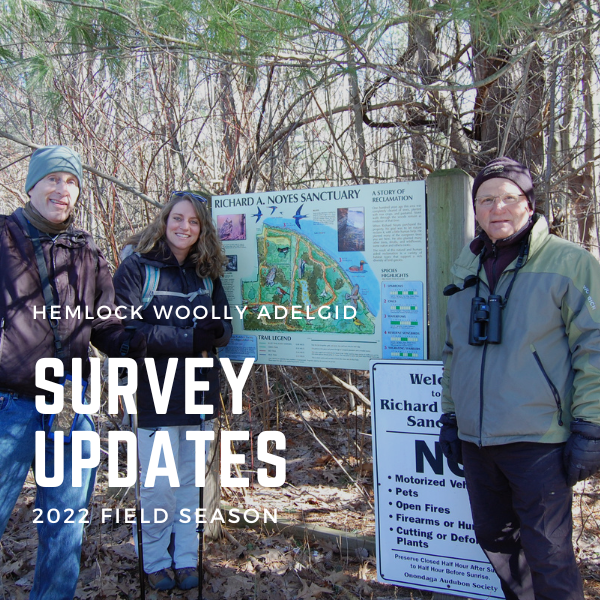This article was featured in the 2022 Summer Newsletter by, Rob Williams and Robert Smith-SLELO PRISM.
Each year during the winter months, when Hemlock Woolly Adelgid (HWA) egg masses are most visible, our early detection team searches Highly Probable Areas for the presence/absence of HWA. Hemlock trees are inspected, and data is recorded using Survey 123 software.
Sites Searched in 2021-22
This past season, 17 sites were surveyed to include the following:
- Altmar State Forest
- Camp Zerbe
- Deer Creek WMA
- Derby Hill Bird Observatory
- Frank E Jadwin Memorial State Forest
- Great Bear Recreational Area
- Happy Valley WMA
- Jackson Hill State Forest
- Lake Julia Preserve
- Little John WMA
- Noyes Bird Sanctuary (HWA Found)
- Rainbow Shores Preserve
- Salmon River Falls
- Sandy Creek State Forest
- Three Mile Bay WMA
- Trenton Greenbelt
- Whetstone Gulf State Park
Past Observations
In 2020-21 HWA were found at six sites including:
- Camp Hollis
- Independence Park
- Mexico Point State Park
- Oswego Co. Reforestation Area
- Selkirk Shores State Park

2021-2022 Observations
Between December 2021 and May 2022, 32 Highly Probable Areas (HPAs) within the 17 Priority Conservation Areas (PCAs) were surveyed by Robert Smith, Brittney Rogers, Rob Williams, Megan Pistolese, Frank Williams, and other volunteers for signs and symptoms of Hemlock Woolly Adelgid (HWA). Of the 32 HPAs searched, Hemlock Woolly Adelgid was detected at 1 HPA (Noyes Bird Sanctuary).
Needle minders (native moth larvae that feed inside conifer needles) were found at 26 sites. Also found was tip blight, caused by the fungus Diplodia pinea (detected at 11 sites).

Each time HWA is positively identified at a site the finding is reported to the landowner and/or land manager along with a referral to manage the adelgids to protect hemlock trees. To date, most of these referrals have resulted in mitigation measures to slow the spread of this forest pest.
At all but three sites surveyed this season, the hemlock crown density was 81% or greater. Positive HWA findings within the SLELO region appear to be concentrated along the Lake Ontario Shoreline and progressing from Cayuga County northward.
Acknowledgments
NYS Department of Environmental Conservation, NYS Office Parks Recreation and Historic Preservation, SLELO PRISM Partners, The Nature Conservancy.


